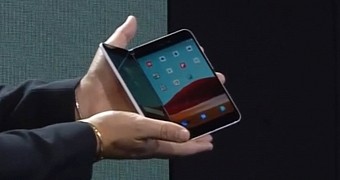Surface Duo is a device that nobody could see coming, that’s for sure. I mean, not even the most prolific leakers out there knew Microsoft was working on an Android device, so let’s be honest, the software giant made a terrific job keeping everything on this project behind the closed doors.
But the Surface Duo is official now, and so is Microsoft’s return to mobile, an industry that the software giant decided to leave behind a long time ago when it abandoned Windows phones.
While Microsoft is back to the mobile party, the term Windows phone no longer makes much sense, simply because Surface Duo runs Android. And this makes Google’s mobile operating system Microsoft’s key platform for everything mobile from now. But is there something more coming from Microsoft in the mobile universe?
That’s hard to say, especially given how much effort Microsoft puts into keeping its most important projects secret, but on the other hand, there’s just one answer to this question.
“There must be more coming from Microsoft in mobile.”
I know that Microsoft’s mobile strategy typically comes down to pioneering new form factors and pushing for innovation with every product, but at the same time, having a rich portfolio of products that addresses the needs of all customers is a win-win strategy for everyone.
For Microsoft, rolling out more devices can make users even more committed to its products, while for customers, these just help them get their job done. In fact, empowering people has been Microsoft’s motto for several years already, and one way to achieve it in mobile is to provide them with new devices.
I said it before and I’m going to say it again: Microsoft’s mobile push needs more than just a revolutionary Surface Duo. It also needs a regular Android phone that would serve as an alternative to the iPhone.
And it’s not like Microsoft can’t release more conventional products. Surface Laptop, which has already proven successful, is living proof that Microsoft shouldn’t always invent new product categories, but stick to the ones that already exist and focus on devices that are better than the ones offered by competition.
At the same time, Microsoft needs a complete mobile device portfolio, and this also involves the launch of a smartwatch. A Surface smartwatch, with or without innovative features powered by the Surface brand, helps Microsoft expand its products beyond the computer or mobile screen, making sure users can access its services even when on the go.
And I’m not talking about an activity tracker. Yes, Microsoft Band was a good effort, and it actually served as living proof that Redmond has what it takes to build wearables, but at the same time, it didn’t align with the strategy that the software giant has embraced. Microsoft needs a mini PC on our wrists to make sure we’re always connected, and this is only possible by investing in a super-capable smartwatch that plays the role of an extension to a Surface computer running Windows.
Microsoft doesn’t necessarily have to copy Apple or Samsung or any other company that builds phones and smartwatches, but only invest in products that make sense going forward. And right now, these are the devices that could perfectly fit its expanding Surface family, while also helping customers do more, regardless of where they are.
Whether or not Microsoft decides to continue its mobile push is something we’ll find out in a couple of years, most likely after the company releases the Surface Duo in the holiday of 2020. A second-generation Duo is very likely anyway, but expanding beyond this form factor in mobile should be a priority in the first place.

 14 DAY TRIAL //
14 DAY TRIAL //